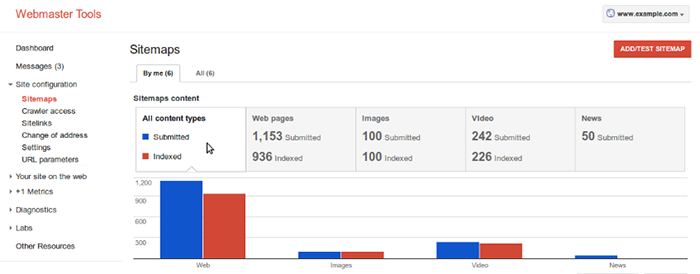Your website is one of the most powerful tools you have for running your business and reaching your audience. It’s the mirror image of who you are and what you do. Also, it’s one of the basic means of information sharing and communicating with potential business partners, visitors, or customers.
This means that you constantly need to work on improving your website. Luckily, Google Webmaster Tools (GWT) is a free tool available for anyone. It can help you learn about your website, improve SEO, and attract more visitors. If you’re not using GWT yet, just keep reading to learn how using it can help you improve your website immensely.
Let’s break it down together.

Improving HTML
Your site’s meta descriptions and title tags play an important role in the way you rank on Google, and how your visitors find you.
HTML issues are a common thing and your website certainly has something you can improve in this area.
GWT offers you insight into your website’s HTML issues and gives you an overview of the things you need to improve.
It shows you critical issues such as:
- duplicate meta descriptions
- short/long meta descriptions
- missing title tags
- non-information title tags
All you have to do is find HTML Improvements report under Search Appearance, and all the issues will be marked yellow.
Then, choose which issues to solve first and this will improve your website’s performance and user experience.
Content Keywords
When it comes to SEO, keywords play a significant role in your rankings. You need to know how to use them, where to place them, and how well they’re working for you.
GWT is very helpful in this area since it gives you insight about your website’s current content keywords status.
Simply put, this tool tells you about the way Google sees your content keywords, in terms of:
- which keywords you’re using
- how often
- how significant they are
- which pages you’re using them on
You can see whether you’re doing a good job, or your keywords need any type of improvement.
Crawl Errors

There’s nothing worse than a visitor trying to reach your page, and learning an error of some type has occurred.
This will automatically push away the visitor, and you won’t see them coming back.
GWT allows you to detect any mistakes or errors your visitors may have experienced. Under the Health Menu, you will find the section about errors. There, you’ll see a report on:
- server errors
- access denied errors
- not found (404 errors)
Detect them and fix them.
Adding Sitemaps
Sitemaps are used as a means of communication between you and Google. To put it simply, you let Google know about the structure of your website.
To create a sitemap, it’s best that you use a tool which can do it for you, instead of doing it manually. For example, there are WordPress plugins which can make this happen.
Once you create your sitemap, you paste its link to GWT.
Now that you’ve got this covered, you wait for GWT to process the new information and start giving you stats. You’ll learn and be notified about:
- number of URLs submitted through the sitemap
- number of URLs that are indexed on Google

The statistics you’ll receive can be divided by the type of content, such as:
- video
- images
- news
- web
You’ll receive alerts when things start to go wrong and you’ll be able to fix it quickly.
Audience Targeting

Another way for you to communicate with Google is to tell it who your target audience is.
GWT allows you to aim your website’s content at a specific group of people and help your content perform better in their country.
All you have to do is:
- go to settings
- choose site settings
- select target users in
- choose a country of your choice
Now Google knows how to treat your content better and ensure you have a better performance in the country you’ve chosen.
Incoming Links Data
Your website is connected to other web addresses via incoming links.
You need to keep an eye on these links and be aware of the different sources pointing out to you.
In the Search Traffic section, you can choose the Links To Your Site option to see all the domains you’re connected to.
The report will help you understand:
- which websites link to you
- how do they link to you
- learn about how many links point to each of your pages
This can help you improve your incoming links strategy and remove potential problems, or links you’re not happy about.
Sitelinks

When Google portrays your website in the search results, it can additionally display sitelinks to help people navigate it.
Typically, you wouldn’t be in control over the sitelinks Google chooses to place as primary.
However, with GWT, you do have a say in it.
You can:
- choose up to 100 links to demote
- allow other links to take priority
By marking the less important links, you’re increasing your chances of having better sitelinks.
Malware Protection
You want to give your visitors the best possible experience while navigating your website.
You don’t want them to be seeing pop-up ads and annoying advertisement, which is why you need to keep your website protected.
If your website is not secure enough, malware may be placed in it. Consequentially, your visitors will experience numerous unpleasant things while browsing through.
Luckily, GWT will:
- detect the issues
- let you know about it
This will ensure you stop the malware and get things back to normal.
Final Thoughts
When it comes to maintaining your website, there’s no excuse. Especially if you have a free tool such as Google Webmaster Tool available and just a few clicks away.
Use the advice above to create your strategy and find out about the essence of your website. Learn about issues, errors, and problems, and remove them easily. Improve your website and you’ll improve traffic and engagement.


